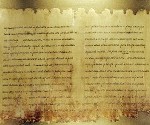 The only four people in the world allowed to touch the 2000-year-old Dead Sea Scrolls are battling a resilient enemy: Sticky tape.
The only four people in the world allowed to touch the 2000-year-old Dead Sea Scrolls are battling a resilient enemy: Sticky tape.
Their weapons: Tweezers, tiny brushes and infinite patience.
“I don’t consider it as work, I consider it as a blessing,” says Tanya Treiger as she runs a scalpel-like instrument around the contours of a small piece of parchment with slow, deliberate and sparing movements.
Treiger is one of four women, all immigrants from the former Soviet Union, in charge of the conservation and restoration of the famed scrolls found half a century ago on the shores of the Dead Sea.
Their job is to ensure the manuscripts on show are exhibited in ideal conditions and to restore the tens of thousands of fragments that suffered not only from the ravages of time but also from past conservation efforts.
Day after day for the past 18 years, they have painstakingly removed adhesive tape that was used decades ago to join matching fragments.
“Scotch tape was just invented and at the time it sounded like a good solution,” says Pnino Shor, who heads the Department of Artifacts Treatment and Conservation at the Israeli Antiquities Authority.
“But in the 1960s it became clear it was a disaster,” she says. “Residues of tape penetrated the parchment and caused its disintegration.”
The conservators, working at a small IAA lab at Yerushalayim’s Israel Museum, will need at least another 18 years to complete the job of restoring the fragments, says Shor.
“What they’re doing is really a first-aid treatment,” she says pointing to one of the women dabbing tiny amounts of organic solvent to remove tape residue and adhesive that has penetrated the parchment.
“If we’re lucky, it comes back to life and the writing becomes clearer.”
Once the fragments are treated, they are arranged on acid-free cardboard, and stored in protective boxes.
Those prepared for exhibition, are placed in polyester netting pockets enclosed between polycarbonate plates.
The fragments are considered one of the world’s most important archaeological finds, and make up about 900 documents of major religious and historical significance.
Discovered between 1947 and 1956 in the Qumran caves above the Dead Sea, the precious parchments and papyrus include religious texts written in Hebrew, Aramaic and Greek, and the oldest known surviving text of Torah.
The oldest of the documents dates to the third century BC and the most recent to about 70 AD, when Roman troops destroyed the second Bais Hamikdosh in Yerushalayim.
The artifacts are housed at the Israel Museum, where the larger pieces are shown at the dimly-lit Shrine of the Book on a rotation basis to minimize damage from exposure.
When not on show, they are kept in a dark, climate-controlled storeroom in conditions similar to those in the Qumran caves, where the humidity, temperature and darkness preserved the scrolls for two millennia.
“If we can preserve them for 2,000 years more we will have done our share,” says Shor.
The custodians of the scrolls are extraordinarily careful in lending some of the parchments for exhibits outside Israel.
They are particularly concerned that utmost care is taking in packaging and shipping, and that conditions replicate those of the Shrine of the Book.
Another concern is Jordan’s claim of ownership.
Jordan says Israel seized the scrolls from a museum in east Jerusalem in 1967 when it occupied that part of the city and the West Bank, which were then under Jordanian control.
Israel has laughed off the claims, insisting the scrolls are an intrinsic part of the Jewish religious, cultural and historic heritage, and have no connection whatsoever to Jordan.
Eventually, those interested in viewing the artifacts should be able to do so from the comfort of their homes, offices or Internet cafes.
Later this year, the IAA will launch an ambitious project to put the entire collection on an Internet databank.
By using infrared, as well as regular photography, experts say many of the inscriptions blackened over the years will once again be visible to the naked eye.
The project also involves using spectral imaging and other high-tech methods to improve conservation.
It will also determine just how many fragments there are – Shor estimates the number at anywhere between 50,000 and 100,000.
Once the entire collection is online, hopefully within five years, anyone will be able to try to match individual fragments to each other without damaging the priceless artifacts, says Shor.
“This is the ultimate puzzleworks.”
{Laredosun.com/Noam Amdurski-Matzav.com Newscenter}












The Dead Sea Scrolls have no relevancy to the Torah world. They were written by Jewish apikorsim — Jewish break-off sects.
what’s written on these scrolls?
Kefira.
Chaim; Learn more before you “posek”. You are off base. One cannot call a person “kofer” vs halakha that was decided centuries afterward. Look back in time to when they were written & delve into what was at that time & realise.
Though yes some parts are by off-course sects but not all. & even the “some” we must judge in the light of the difference in what was correct by the sages of those times.
Kefira is kefira.